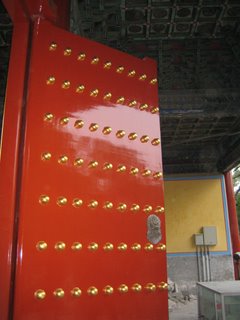Thirteen Ming Tombs

Today's trip took the students to the Shi San Ling, or the Thirteen Ming Tombs located about 30 miles outside of the city, surrounded by great craggy green mountains and lots of mist. The bus ride was long, and for some reason I would up sitting next to one of the second-year da ban ke laoshi (lecturers), Tian Laoshi, so had to make Mandarin conversation for most of the trip, which wound up being nicer than I would have thought, given my usual state of coherence at 7am, which is when the buses departed. Tian Laoshi will be coming to Harvard to teach Chinese in the fall, and I was interested to find out if he was excited about coming to the States, which is no small feat for a teacher in China. His answer took me a little by surprise: "Yi qian, wo fei chang xing fen qu mei guo, ke shi, ha fo bei jing shu yuan yi hou, wo you yi dianr jin zhang... wo jue de HBA hen lei -- ha fo ye hen lei -- wo bu zhi dao shi fuo wo shou de liao!" (Before, I was very excited, but after teaching at HBA (and seeing how exhausting it is, both for students and for teachers alike) I'm not so sure... Harvard will probably be as exhausting, I don't know if I'll be able to stand it!)
After more fascinating conversation with Tian Laoshi (I'm only being a little sarcastic, I promise), the buses finally arrived at the ceremonial entrance to the Shi San Ling, a giant, beautifully carved gate leading down a long stone path. This path is the spirit avenue, lined on either side with stately rows of trees and guarded by 36 stone statues. Carved in the 15th century, the statues included 24 animals and 12 humans. The human statues stood at attention, dressed in ceremonial garments appropriate for the presence of the emperor. The early morning mist cast a hush over the strolling students, and the stone guardians at either side seemed to watch us austerely as we made our way quitely down the great avenue, on our way to pay homage, as so many had for so many centuries before us, to the thirteen Ming emperors entombed at the end of the path.
We made our way to the first of the great tombs, and I was simply amazed by the richness, complexity, and symbolism contained in this striking example of Ming architecture. A series of star gates and courtyards formed the approach to the great tomb burial mound. Like the the Forbidden City, the Ming tomb buildings have yellow roof tiles. Yellow, the imperial color of Chinese royalty, was also to be found inside the restored tomb buildings. Large red doors studded with golden knobs in patterns of nine by nine symbolize luck (red) and prosperity (nine) for the desceased emperor and his kingdom. The many gates guarding passage to the tomb building are designed to bring luck and good fortune to those passing through, and are built to keep gui (ghosts, or evil spirits) out of the sacred area. Traditional Chinese buildings sit on raised platforms, sometimes with multiple layers of terraces and balustrades, meant to bring honor to the deceased. These are just a few of the abundance of amazing things I saw and wondered about at the Ming tombs, which sadly have no visual record due to the nonexistence of my camera batteries, but this website has got a fabulous amount of information about the architecture of these monuments.




<< Home